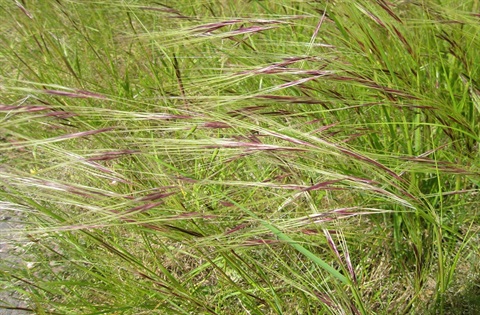Chilean Needle Grass - Time to Act - Weed of National Significance
Published on 30 October 2025

Chilean Needle Grass (Nassella neesiana) is a perennial tussocky grass that grows in clumps over 1 metre tall and 1.5 metres when in seed. It is a serious agricultural weed and a threat to native ecosystems. Chilean Needle Grass (CNG) can displace palatable pasture species reducing productivity. It is nearly impalatable once in the reproductive stage and the panicle seed can readily attach to stock, particularly sheep, with it’s presence in wool downgrading quality of fleece. CNG sharp seeds can burrow into the skin of stock, and sometimes muscle, and may cause ulcerations in the mouth. CNG out-competes native grass species threatening native grasslands and once established seed banks can be difficult to manage.
CNG is known to occur within Murrindindi Shire and Landowners and Council each have a part to play to contain and control this dangerous weed.
What is Council Doing?
Council has been actively trying to contain and control the spread of CNG on Council managed land for many years.
CNG is present on some Council roads and reserves including parts of the rail trail between Molesworth and Homewood. CNG is also present on Department Transport main roads such as the Goulburn Valley Highway and Melba Highway. In the past, treatment has consisted of spot spraying roadsides and reserves with Glyphosate, a known herbicide suitable for treatment.
Despite annual spot spraying, CNG is still persistent. Council will be using another herbicide this year, Flupropanate, in addition to Glyphosate. Flupropanate can kill the seedbank as well as the plant and reduce reinfestation.
Flupropanate is fully registered for control of CNG. It is a slow acting herbicide, absorbed through plant roots and can take between 3 months and 12 months after application for entire plant to die, depending on weather conditions. Flupropanate is a residual herbicide which means it remains present in the soil to prevent germination of seeds yet to emerge from the soil seed bank. Flupropanate will only be used every few years and is applied as a spot spray, not a broad application.
Flupropanate has a withholding period and lactating cattle should not be allowed to graze on treated areas. The roadsides and reserves that Council intends to spot spray should not impact on private enterprise however should you have concerns on moving cattle from one paddock to another via a municipal roadside within the Molesworth to Homewood area please contact Council to discuss on (03) 5772 0333.
Roads included in the program include Limestone Road, Killingworth Road, Carey Road, Deepdene Road, Murrays Road, Native Dog Road, Racecourse Road and Abes Lane. Reserves included in the program include Pioneer Reserve, Sloan Reserve Picnic area, Molesworth Station, Great Victorian Rail Trail.
Blue dye will be used in the spot spray to enable easy identification on roads within the treatment area. As Flupropanate has a residual life, treated areas should not be grazed or cut for stock food until withholding period expiry.
What Can Landowners Do?
Landowners can check for this weed on their land. CNG produces three types of seed; panicle seed on seed heads, in the stem and at base of plant. Seeds can remain viable within the soil for years. It is a highly invasive plant spread predominately by vehicles and machinery. Slashing is high risk activity that can infest other areas with seeds. Seeds can also be spread by water and soil movement, by animal movement, such as stock, native animals and pets, and also by the introduction of fodder to site, With the recent drought conditions experienced locally and the purchasing of fodder, now and throughout spring into early summer is the time to check the paddocks to determine its presence.
CNG is similar looking to the native spear grass Austrostipa spp, here are some helpful methods to identify CNG:
- CNG has a heavy seed so stems can often be quite bent over with weight. Austrostipa spp has a lighter seed and stands more erect.
- CNG has long awns attached to the seed head. If pull out an awn and you see a distinct corolla around the base of the seed head, this can distinguish it from Austrostipa spp.
It is important to treat CNG if discovered on your property.
If you are moving stock between paddocks on these targeted roadsides, stop them grazing. Grazing on roadsides or droving stock longer distances require a permit.
Working Together
If you notice CNG on your land or Council-managed please report your findings to Council.
More information on CNG can be found at Weeds Australia.
Any queries regarding proposed spray program please contact Environmental Programs Unit on (03) 5772 0333.